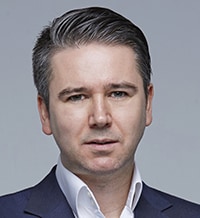Digital banking, cryptocurrencies, ecommerce and fintech start-ups—2017 was a record year for digital investments in the MENA region. But there’s wide variation between countries.

The MENA fintech sector is booming, with more than $100 million raised by start-ups in the last decade. Dubai-based digital research network Wamda’s State of Fintech report released last March predicted the total for just that year would reach $50 million, an increase of 270% over 2016.
The figures might look modest compared to the rest of the world, where total investment in fintech start-ups from 2010 to 2016 stood at $63 billion, according to the Wamda report; but for a nascent market the growth rate is explosive, with dozens of new start-ups launching every year.
In 2017 some of the major deals included a $20 million capital injection in Saudi Arabia’s online payment solution PayTabs; a $10 million round by three investors, including UK firm Gocompare, for Emirati price-comparison platform Souqalmal; $13 million for Emirati Cloud HR and insurance platform Bayzat; $5 million for Emirati peer-to-peer lending company Beehive; and $3.5 million for Emirati comparison website Yallacompare.
Although online payments, remittances, crowdfunding and peer-to-peer lending attracted the largest tickets, fast-growing fintech subsectors include cryptocurrencies, artificial intelligence and digital wallets.
Islamic finance is another key area of potential growth. Late in 2017, the Kingdom of Bahrain launched the world’s first shariah-compliant fintech consortium. This collaborative effort between 11 regional banks should result within five years in 15 new fintech solutions. For MENA-based banks and entrepreneurs, shariah-compliant innovation is a chance to tap into new and fast-growing markets such as Central Asia, Southeast Asia and Sub-Saharan Africa.
Lands of Opportunity
The MENA region has the highest percentage of unbanked population worldwide, with only 14% of adults owning a bank account as of 2014. At the same time, the region boasts a large proportion of tech-savvy youth. Mobile-phone penetration is high, with 365 million unique subscribers accounting for 63% of the population in 2017. Mobile-Internet penetration stood at 38% as of 2016 and is expected to grow to 48% by 2020.
So far, existing banks have been quite traditional in their approach to fintech, investing mostly in digitization of their existing services rather than in disruptive technologies. For new entrepreneurs, this represents a unique window of opportunity, with an untapped market of hundreds of millions of potential users that could leapfrog from the cash economy into the world of digital financial inclusion. That being said, Wamda’s research highlights that “banks may lack innovation, but start-ups lack trust”—and that opens up the need for collaboration. Data show that 88% of fintech start-ups seek corporate partnerships.

One of the reasons why entrepreneurs seek partnerships with established financial institutions is that the MENA market is particularly fragmented. One of the main challenges faced by fintechs is the lack of integrated regulatory policy across the 24 countries of the region.
“Companies are looking to scale regionally; but that comes at a higher cost than in other parts of the world, because each country is so different,” says Craig Moore, CEO of Beehive—the only UAE peer-to-peer lending platform regulated by the Dubai Financial Services Authorities (DFSA).
Access to funding is also somewhat limited. The region has a good number of angel investors, but venture-capital or private-equity firms are fewer and have limited funding capacities compared to peer elsewhere.
“The whole region has a gap in early stage equity funding,” says Walid Hanna, founder and CEO at Middle East Venture Partners (MEVP), a Dubai-based regional VC firm that has already invested over $40 million in start-ups such as TreasuryXpress, including $1.1 million in PinPay and $700,000 in HyperPay. “Every country is different: In the UAE, Dubai in particular, and in Saudi Arabia, there is a gap or a need in series B funding—while in other countries, like Lebanon and Jordan, the funding gap is in series A.”
Another hurdle MENA start-ups have to overcome is the low availability of tech talent in cutting-edge fields like UI/UX, artificial intelligence, coding or data analytics. To bridge that gap, tech schools and bootcamps have opened in many parts of the region. They typically target university students and offer them intensive courses where they can learn all the digital skills required to work as a web developer.
Money and Talent
Looking more closely at the regional breakdown of investments, the UAE attracts the lion’s share. According to a report released by Magnitt—a regional network for entrepreneurship and investment—the UAE received 70% of the $410 million (excluding the Careem and Souq deals) raised by all MENA start-ups in 2017. The second country was Saudi Arabia, with only 9%.
“Although it’s expensive to operate a business from the UAE, it remains the most attractive country because this is where regional clients and global HQs are,” says Omar Christidis, CEO and founder of Arabnet, a regional events and media company focused on the digital economy. “It’s also where you find the largest investor community—one out of three MENA investors is based in the UAE.”
The UAE is home to more than 30 funding institutions. And it has by far the most developed fintech ecosystem, with players like Abu Dhabi Global Markets (ADGM), which operates the first fintech regulatory sandbox in the region; and the Dubai International Financial Center (DIFC), which heads a $100 million fintech fund and FinTech Hive, the Arab world’s first fintech accelerator.

In early March, MEVP signed a first memorandum of understanding with the DIFC. This partnership aims at improving regulatory frameworks and boosting investment. “Increased cooperation between both parties will be key to stimulating growth and investment activity in Dubai’s venture capital sector. We are particularly excited that our MoU will provide a platform for MEVP to explore co-investment and co-management opportunities in relation to DIFC’s $100 million fintech fund,” said Arif Amiri, DIFC’s CEO, at a press conference.
“The UAE is now the primary hub for founders from not only Arab countries, but also South Asia, Europe and other places, who eye the MENA, South Asian, and SSA markets,” says Wamda Capital partner Fares Ghandour in an interview with Arabnet.
Other countries in the region, however, also offer access to those markets—and wide-open opportunities to launch new business, as well—and are hence worthy of closer consideration from entrepreneurs.
Lebanon was one of the first MENA countries to invest massively in the digital economy. Back in 2013, the central bank, Banque du Liban, issued a circular guaranteeing up to $400 million worth of investments in innovative technologies, later raising that amount to $600 million. Today, the country is home to 15 funding institutions, as well as a myriad of accelerators and start-up support programs.
Lebanon is a small market of about 4 million inhabitants, but in comparison to the rest of the region it has key competitive advantages: very skilled and relatively low-cost labor, a highly developed banking sector and a global diaspora of 8-14 million people.
For Beirut, the goal is to leverage the strength of the local banking industry to become a fintech leader. If Dubai is essential for marketing and clients, Lebanon can position itself as the back office. The country is starting to see some success stories like online payment-card system Nymcard, which just raised $3 million in series A. Banks are also looking at direct collaborations with fintechs like Fransabank, which invested $2.5 million in online-payment platform PinPay.
Sleeping Giants
Egypt has the largest population in the region, with over 98 million people. This market has some of the characteristics of the African market, with a very low-income population and a vast territory, which makes it difficult for branch banking. The recent political and economic crisis slowed down the tech sector; but leapfrog opportunities are huge, and it’s not surprising that mobile transaction platforms like Fawry, which sold for $100 million in 2015; or DCBEgypt, acquired by regional leader TPay in 2017, are a hit.
“With 110% mobile penetration rate in Egypt, and only 10% of the population with access to financial services, we see a huge growth opportunity in secure and cost-effective financial services delivered via mobile phone,” says Hisham Ezz Al-Arab, Chairman and managing director at Egypt’s Commercial International Bank (CIB). “There is an enormous potential for fintech in Egypt.”
For Al-Arab, the youth and the unbanked populations represent huge growth opportunities. “Tailoring truly customer-centric digital products is the ideal way to attract these dynamic segments,” he adds. In recent years, CIB adopted a two-pronged strategy to capitalise as much as possible on digital innovation. The bank partnered with Cairo’s American University to set up a 12-week Fintech Accelerator program, and also set up its own in-house Digital Innovation Lab in 2017.
Saudi Arabia also has a lot of potential, especially since the authorities have started showing a will to to use some of their financial power to diversify their oil-dependent economy. The kingdom has over 33 million inhabitants and the largest consumer spending worldwide.
Fintech is expected to be at the heart of Riyadh’s $10 billion new financial district, and recent tech investments include a partnership between the Saudi Public Investment Fund and Japanese SoftBank Group to launch a $100 million tech fund.
One technology that Saudi Arabia is particularly looking at is blockchain and cryptocurrencies. To make sure they stay on top of the game, Saudi authorities are pushing for deals with Western fintechs and regional partners. In February, the central bank signed with US start-up Ripple to provide a blockchain-based payment solution to local banks. This deal is a first of its kind and aims at allowing financial institutions to process payments in a cheaper, faster and more transparent way. In October, the Jeddah-based Islamic Development Bank announced collaboration with Belgian start-up SettleMint to develop new Sharia-compliant products based on blockchain innovation.

Although Gulf countries have always been cautious about digital currencies—Bitcoin in particular—the Saudi central bank announced in 2017 a partnership with the United Arab Emirates central bank to develop a special cryptocurrency that would facilitate cross-border transactions. In its first stages, this currency will not be made available to individuals; only financial institutions will acesss it.
“There are tremendous opportunities for foreign or regional tech companies who are ready to collaborate with local partners to capture local opportunities,” says Arabnet’s Christidis, who recently launched a report on Saudi Arabia’s innovation economy.
The report shows, however, that access to funding is the first impediment start-ups face in Saudi Arabia. While 55% of the entrepreneurs surveyed said they were in need of financial support, 47% said it is “very hard” to find those funds, and 24% said it’s “somewhat hard.” Most tech start-ups rely on non-equity funding—56% of respondents claimed to have used their personal savings, while 11% claimed to have used competition money, and another 11%, bank loans.
“When it comes to equity funding, 24% of start-ups surveyed have raised funding from angel networks. Only 9% of start-ups surveyed say that they have raised funding from a VC, indicating a clear opportunity for venture capital,” concludes the report.
Other countries should also be watched closely—including Jordan, Kuwait, Bahrain and Morocco. For now, the tech sector there is still in its very first stages. That might be just the right time to get in.



